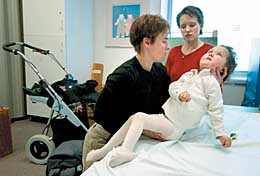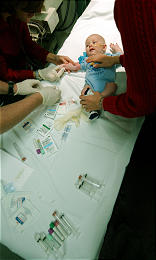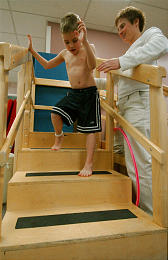|


Tests aim to solve genetic mysteries

Orem family among
those with the disorder
By
Lois M. Collins
Deseret Morning News
Colin English at 3
1/2 months is a normal, healthy baby boy. The only hint of what
his future may hold is the tube that runs into his nose and down
through his stomach to make giving him medicine easier.

Physical therapist Janine Wood performs tests on 3-year-old
Taleah English while Taleah's mother, Monica English, watches
at Primary Children's Medical Center.

Michael Brandy, Deseret Morning News |
His parents, Monica and John English, know that, unlike his
sister Taleah, he will one day sit up and may even walk.
Taleah, 3, reclines on a special stroller, always flat
because she cannot swallow easily. Her hold on life is fragile,
but she is vibrant and, though physically restricted, very active.
The difference between the two is the number of copies of a
gene called SMN2 (survival motor neuron 2), a protein that helps
motor neurons survive, as the name implies, says Dr. Kathryn
Swoboda, a neurologist, geneticist and researcher at Primary
Children's Medical Center. She is conducting clinical trials in
hopes of changing the future of children like Taleah and Colin,
who were born with spinal muscular atrophy.
SMA, its common shorthand name, is a recessive disorder;
both parents have a specific gene deletion that causes the
disease. But since one in 40 are carriers, it's not that uncommon.
The chance of a child having SMA in those families is one in four;
Taleah and Colin have older siblings who don't have the disorder.
The diagnosis, years ago, was without hope: muscle weakness
and atrophy, inability to swallow, death. These days, the National
Institutes of Health believes the odds of a cure or at least
drastic improvement are so high that it has provided funding as a
transitional research project.
Swoboda is using drugs to manipulate the SMN2 copies that
determine how well children with SMA do. Sodium phenylbutyrate,
used for years in newborns with other disorders, is known to be
safe. The question is, is it effective with SMA? There are
concerns about using another drug, valproic acid, in newborns. But
it holds great promise. Valproic acid also is used for other
conditions, such as seizure control in people with epilepsy or as
a mood stabilizer in folks with Alzheimer's.
Both drugs were picked up as a possible SMA treatment on a drug screening
survey. They work by the same general mechanism. They open up the
DNA and allow genes that normally are not expressed to be
expressed at a higher level.
Animal research indicates the drugs may "rescue the picture"
in mice with SMA. It's just one approach. Other work shows that
infusing stem cells into rats who are paralyzed gives them the
ability to walk. But it's early work. And it's hard to get stem
cells into the nervous system. With SMA, muscular symptoms are
actually secondary to devastating nerve deficits.
So on a December day, Mitchell Kohler, 7, is lying on a bed
at Primary, watching a Scooby-Doo movie while Swoboda delivers
little electric shocks and measures them. He takes valproic acid
to see if it will help his disease. The shocks, he says, "feel
like a goose pecking at me. A mean goose."
Mitchell has type 3, meaning he has much less-severe SMA. He
walks, but his mom, Kellie, who has made the trip with him from
Boise, Idaho, says he's clumsy and sometimes just falls down. It
is possible that sometime in the future he will lose the ability
to walk, but for now he's an active little boy who loves taking
gymnastics.
His SMA first showed up when he was a little over 2. He was
"walking funny and couldn't get up right," Kellie Kohler says.
Colin and Taleah wait in the hallway because they're up next
for the testing. Taleah has the most severe form, type 1. Colin is
a type 2. Children with SMA have various numbers of copies of the
SMN2 gene, which determines the degree of disability. The number
ranges from 0-6, with more severe disease for those with fewer
copies. Colin has 4.

Colin English is examined and has his blood drawn by Dr.
Kathryn Swoboda and nurses. Colin has spinal muscular atrophy.

Michael Brandy, Deseret Morning News |
Type 1 patients such as Taleah live abbreviated lives,
felled prematurely by their fragility and complications. She has
been extremely weak since she was 4 months old and is terribly
susceptible to illness, especially respiratory problems. She is,
at 3, a relatively old type 1 SMA child. As many as 90 percent die
by age 2. Her mother, Swoboda notes, "takes exquisite care of
her," but has still almost lost her several times.
Monica English shrugs at the praise. "When you are told your
child has a terminal illness and no one can give you hope, you
find your own way," she says.
Type 2 children live longer, but their lifespan is
shortened. Someone with Type 3 can have a very normal lifespan.
And there's some guesswork involved. Someone can be a "weak type 3
or a strong type 2," for instance, and it's hard to tell for sure,
Swoboda says. She knows a man in his 30s who has six SMN2 copies
and can run and is strong. But he has the double genetic deletion
that is SMA.
Some families with kids who have SMA fly into Salt Lake from
far away to participate in the yearlong study. For several months,
testing and physical therapy establish a baseline. Then they're
given one of the medications (they're being compared for
effectiveness) for the rest of the year to see what it does.
Because Taleah has SMA, her baby brother was tested while
still in the womb. He was enrolled in the study and given the
study medication first when he was 3 days old, in hopes of
preventing the disease's progression.
"We won't know for a couple of years if we've changed
Colin's course," Swoboda says. "If we help him from birth, there's
a better chance of catching it before his motor neurons drop."
If the drugs work, researchers dream that a type 1 case
could be turned into a type 2 or a type 3. They can't be given the
deleted genes, but damage could be limited.

Physical therapist Janine Wood works with 7-year-old Mitchell
Kohler. Mitchell has type 3, a less severe form of spinal
muscular atrophy.

Michael Brandy, Deseret Morning News |
Swoboda's is the pilot site for Project Cure SMA, funded by
Families SMA. The national coalition of SMA families provides up
to $200,000 a year for the research. Others, like Miracle Flights
for Kids, help. That group flies the children to the study free,
using air miles other people have donated. Local foundations are
helping as well.
Right now, 60 SMA children are enrolled in the project and
must be assessed every two or three months. The drugs are taken
orally on a daily basis (Colin, for instance, takes his four times
a day).
And the parents aren't just waiting for a clinical trial to
solve their child's problems, either. When Taleah was 7 months
old, she lost her ability to swallow. The English family flew from
their home in Orem to New Jersey to explore new treatments there
and brought back with them some of the methods used to help
children breathe and clear their lungs. Swoboda has gratefully
adopted whatever works for her other patients. For instance,
Taleah uses a machine called a BiPap to help her lungs expand when
she sleeps and another to help her cough.
The little girl is very bright and her parents try hard to
find the balance between keeping her safe from germs and denying
her a full life. She goes to the zoo once a year. The extended
family recently took a wagon ride to see Christmas lights at an
area display. But it is quite a production to leave the house, so
the trips aren't as common as the little girl would like, Monica
English says. Once a year, the family goes to the SMA convention,
where she socializes with other children who share her
limitations. When the time comes, she will go to public school.
She now provides some of her own care, holding out her hand
for the suction device that clears excess saliva. She knows what
medicine she's supposed to take and when she needs specific
treatments. "The things we do are things she asks for."
With careful, tender care, Taleah may live a long time. Or
she can die tomorrow, a truth her mother knows well. She's done
mouth-to-mouth on her daughter and learned to live "moment to
moment."
They find joy when Colin kicks his tiny legs, in part
because it was a joy Taleah never had, Monica English says. But
they also embrace "things I would never have experienced without
experiencing Taleah. She is the most patient child. And she has
helped me appreciate life itself in a way I never did before."
E-mail: lois@desnews.com
|
![]()